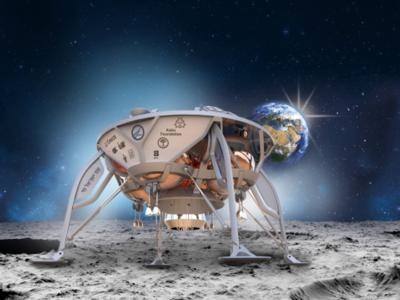Wed, Feb 13, 2019
In Partnership With SSL, Spaceflight Will Send Its First Rideshare Mission To Geosynchronous Transfer Orbit
Satellite rideshare and mission management provider Spaceflight will launch two payloads on its first rideshare mission to Geosynchronous Transfer Orbit (GTO). The mission is scheduled for no earlier than mid-February 2019 aboard a SpaceX Falcon 9 launching from Launch Complex 40 at Cape Canaveral Air Force Station, Florida.

The primary payload on the mission is a telecommunications satellite for the South East Asia region. It was built by SSL, a Maxar Technologies company, which also procured the launch vehicle. Spaceflight will manage the launch of the two secondary payloads, Israeli non-profit SpaceIL’s lunar lander, and the U.S. Air Force Research Lab’s (AFRL) experimental small satellite, S5.
This will be Spaceflight’s first mission beyond Lower Earth Orbit (LEO) and its first combined launch with SSL. In addition to securing capacity aboard the launch vehicle, Spaceflight is handling all the mission management and integration services for the lunar lander, called Beresheet (Hebrew for in the beginning), and AFRL’s spacecraft. This includes a multitude of services, from the unique aspects of pre-launch design, assembly, and integration to the final analysis and testing of the architecture before the spacecraft are encapsulated into the rocket.
While rideshare missions are becoming more and more routine, Spaceflight’s first GTO mission stands apart for several other reasons:
- The spacecraft are headed to two different orbits. Once the Falcon 9 reaches GTO, it will separate SpaceIL’s lunar lander with a custom separation system. Beresheet will orbit Earth, gradually increasing its apogee until it can maneuver to be captured by the Moon's gravity. It will travel to the Moon’s surface under its own power, a voyage taking nearly two months.
- Following Beresheet’s deployment, the AFRL spacecraft, built by Blue Canyon Technologies, will remain attached to the telecommunications satellite as they continue their journey to Geostationary Orbit (GEO). Before the telecommunications satellite reaches its final GEO position, it will separate the S5 spacecraft which will then turn on and start its mission.
- SpaceIL’s four-legged lunar spacecraft, which was competing in the Google Lunar XPrize, will be the smallest spacecraft to land on the Moon, at only 1,322 pounds. Once it has completed its mission, Beresheet will represent Israel’s first spacecraft and the world’s first privately funded spacecraft to reach the Moon. Its mission is to transmit photos and video of its new home and conduct scientific measurements. Upon the mission’s completion, it will remain as a lunar time capsule commemorating this historic accomplishment.

“This is an important mission for Spaceflight as we expand and evolve our customer offerings,” said Curt Blake, CEO of Spaceflight. “The launches we pursue continue to get more sophisticated and demonstrate that our expertise goes beyond identifying and scheduling launches. We also offer valuable integration and deployment services that enable our customers to reach space in a cost-effective manner and get to their desired orbit successfully. With this mission, Spaceflight is demonstrating that the Moon is in reach.”
This mission marks Spaceflight’s inaugural launch of 2019 and the first mission following SSO-A, its historic dedicated Falcon 9 rideshare mission, which launched 64 unique smallsats from 34 organizations from 17 countries in December 2018.
(Images provided with Spaceflight news release)
More News
Aero Linx: Model Aeronautical Association of Australia MAAA clubs are about fun flying, camaraderie and community. For over 75 years, the MAAA has been Australia’s largest fl>[...]
Touchdown Zone Lighting Two rows of transverse light bars located symmetrically about the runway centerline normally at 100 foot intervals. The basic system extends 3,000 feet alon>[...]
“Discovery and innovation are central to our mission at Virgin Galactic. We’re excited to build on our successful record of facilitating scientific experiments in subor>[...]
How To Get A Story On Aero-TV News/Feature Programming How do I submit a story idea or lead to Aero-TV? If you would like to submit a story idea or lead, please contact Jim Campbel>[...]
Student Pilot Reported That During Rotation, “All Of A Sudden The Back Of The Plane Kicked To The Right..." Analysis: The student pilot reported that during rotation, “>[...]
 ANN's Daily Aero-Linx (05.02.24)
ANN's Daily Aero-Linx (05.02.24) ANN's Daily Aero-Term (05.02.24): Touchdown Zone Lighting
ANN's Daily Aero-Term (05.02.24): Touchdown Zone Lighting Aero-News: Quote of the Day (05.02.24)
Aero-News: Quote of the Day (05.02.24) ANN FAQ: Contributing To Aero-TV
ANN FAQ: Contributing To Aero-TV NTSB Final Report: Cirrus Design Corp SR20
NTSB Final Report: Cirrus Design Corp SR20




